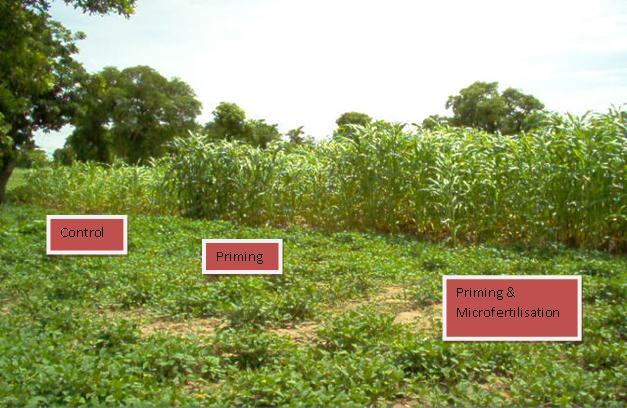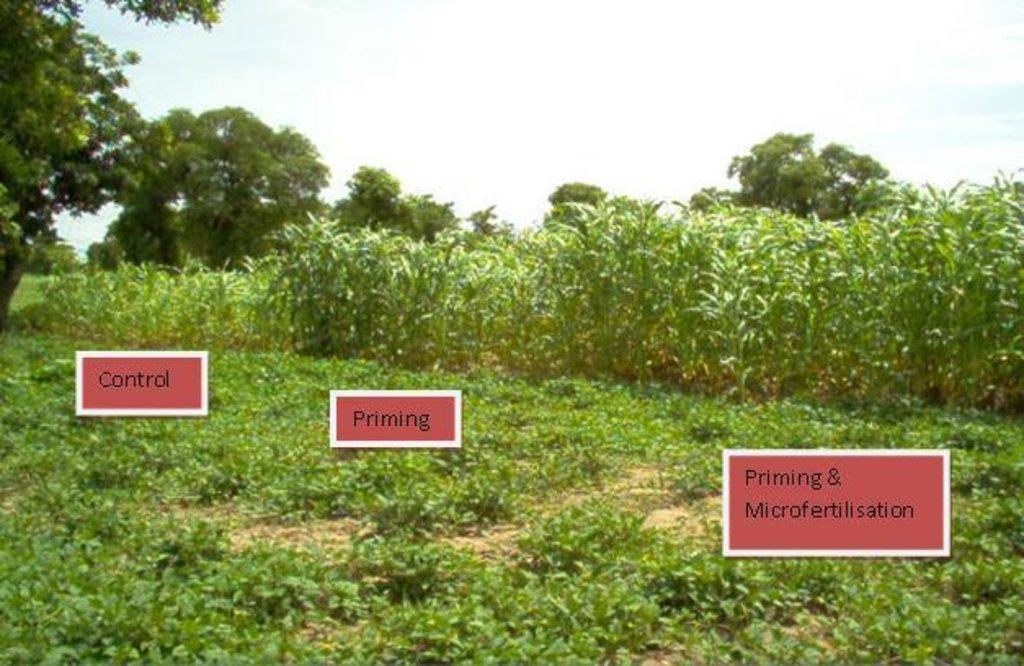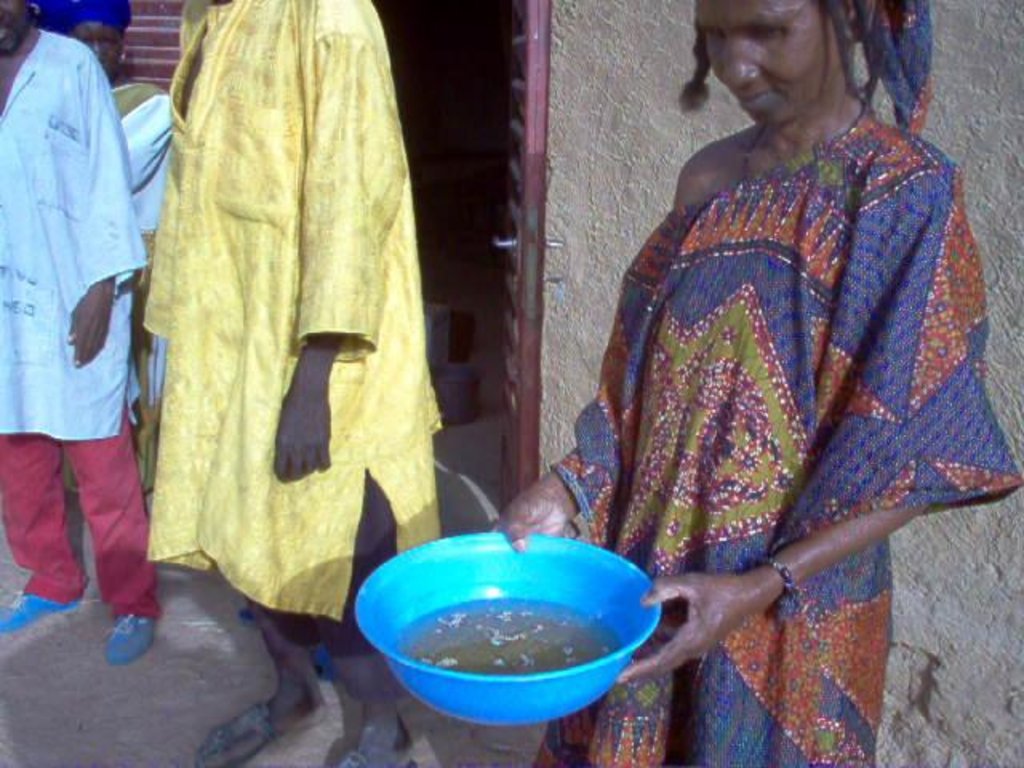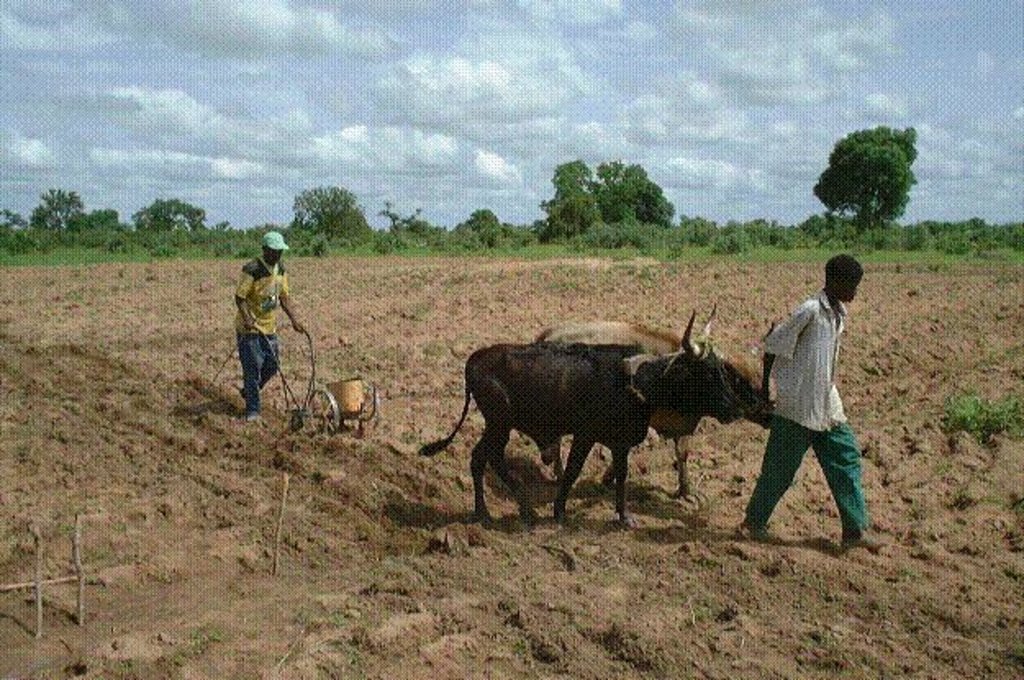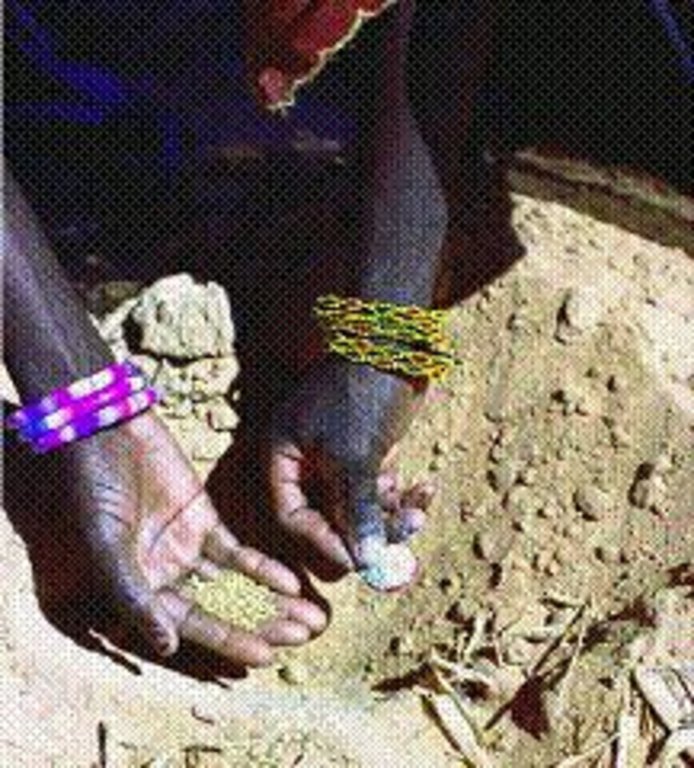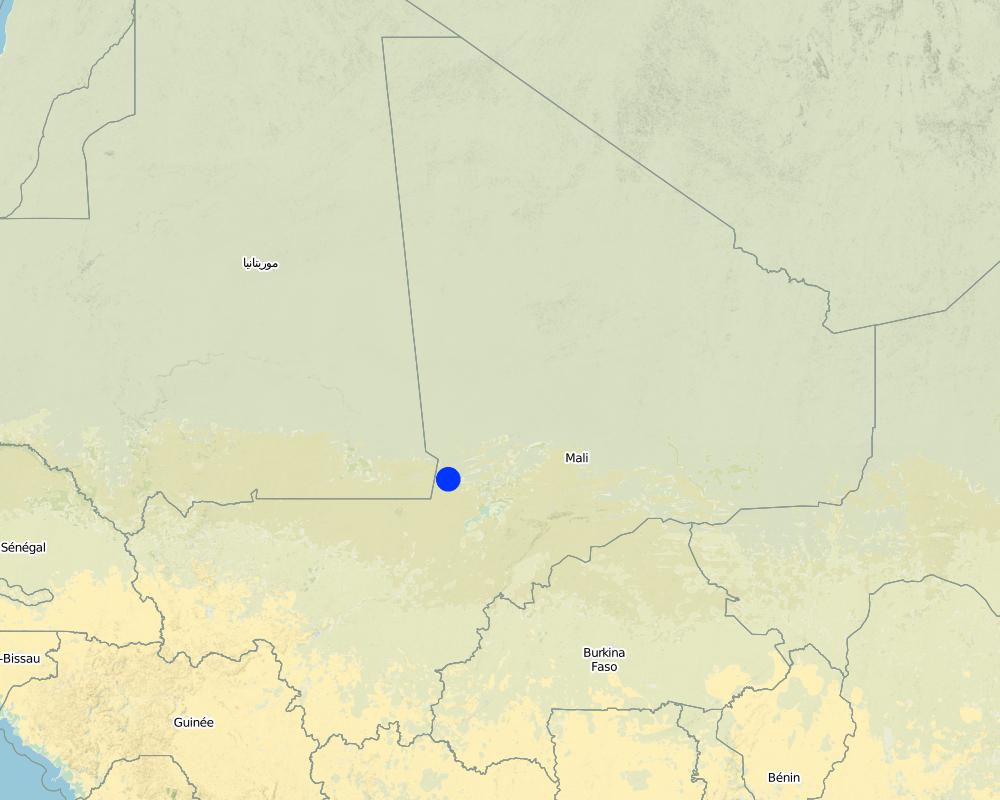Seed Priming and Microfertilization [马里]
- 创建:
- 更新:
- 编制者: Unknown User
- 编辑者: –
- 审查者: Fabian Ottiger, Alexandra Gavilano
technologies_1328 - 马里
查看章节
全部展开 全部收起1. 一般信息
1.2 参与该技术评估和文件编制的资源人员和机构的联系方式
关键资源人
SLM专业人员:
Aune Jens
Norwegian University of Life Sciences
挪威
有助于对技术进行记录/评估的项目名称(如相关)
Book project: SLM in Practice - Guidelines and Best Practices for Sub-Saharan Africa (SLM in Practice)有助于对技术进行记录/评估的机构名称(如相关)
Norwegian University of Life Sciences (Norwegian University of Life Sciences) - 挪威1.3 关于使用通过WOCAT记录的数据的条件
编制者和关键资源人员接受有关使用通过WOCAT记录数据的条件。:
是
2. SLM技术的说明
2.1 技术简介
技术定义:
Seed priming and microfertilization are two agronomic measures to increase soil fertility and increase crop harvests in semi-arid drylands.
2.2 技术的详细说明
说明:
Seed priming consists of soaking seeds for 8 hours prior to sowing and microfertilization is the application of small amounts of mineral fertilizer to the planting hole.
Purpose of the Technology: Seed priming and microfertilization have been found to be effective in increasing pearl millet and sorghum yields under dryland cropping systems. It is also applicable for cowpeas, groundnuts and sesame. Priming will increase the water use efficiency because the seed can start to germinate immediately after sowing. Results from Mali (Koro and Segou) show that yields can be increased by 50 % if microfertilization is combined with seed priming. Other benefits are reduced labour constraints (thanks to simultaneous application) and risk reduction. Seed priming and microfertilization can be practiced independently from each other; however, the combination reduces the risk of crop failure and shows best results in terms of yield increase. Microfertilization has also been mechanised in Mali.
Establishment / maintenance activities and inputs: Seed priming should be carried out after a rain shower sufficient for sowing (15-20 mm) at the beginning of the rainy season. After soaking, the seeds should be air dried for 1 hour prior to sowing (to reduce the stickiness of the seeds and to reduce risk of burning by fertilizer). Fertilizer (NPK 16-16-16; or DAP) is applied at a micro-dose of 0.3 g per planting station, equivalent to 3-8 kg fertilizer/ha, dependent on plant population density. The air-dried seeds and the fertilizer can be applied simultaneously by first mixing the seeds and the fertilizer and thereafter taking a pinch of the mixture between the thumb and the forefinger.
Natural / human environment: The Mopti region is located in the semi-arid Sahel with an average annual rainfall of 400-800 mm during one 3.5 month rainy season. A participatory rural appraisal (PRA) study undertaken in 1999 identified soil fertility as one of the farmers’ most serious constraints.
2.3 技术照片
2.5 已应用该技术的、本评估所涵盖的国家/地区/地点
国家:
马里
区域/州/省:
Mopti Region
有关地点的进一步说明:
Koro
Map
×2.6 实施日期
如果不知道确切的年份,请说明大概的日期:
- 不到10年前(最近)
2.7 技术介绍
详细说明该技术是如何引入的:
- 在实验/研究期间
- 通过项目/外部干预
3. SLM技术的分类
3.1 该技术的主要目的
- 改良生产
- 创造有益的经济影响
3.2 应用该技术的当前土地利用类型

农田
- 一年一作
注释:
Major land use problems (land users’ perception): soil fertility decline, insufficiency or unavailability of arable lands, population growth and its impact on reducing land availability, frequency and length of fallow periods, insufficient flooding of the plains, increasing soil erosion
3.4 供水
该技术所应用土地的供水:
- 雨养
3.5 该技术所属的SLM组
- 土壤肥力综合管理
- Seed priming
3.6 包含该技术的可持续土地管理措施

农艺措施
- A2:有机质/土壤肥力
注释:
Main measures: agronomic measures
3.7 该技术强调的主要土地退化类型

化学性土壤退化
- Cn:肥力下降和有机质含量下降(非侵蚀所致)
注释:
Main type of degradation addressed: Cn: fertility decline and reduced organic matter content
Main causes of degradation: soil management (Use of organic and inorganic fertilisers lower than recommended, reduction in fallow period), crop management (annual, perennial, tree/shrub) (removal of crop residues), other human induced causes (specify) (clearing and cultivation of marginal lands), other natural causes (avalanches, volcanic eruptions, mud flows, highly susceptible natural resources, extreme topography, etc.) specify (natural low soil fertility and fragile soils), population pressure
3.8 防止、减少或恢复土地退化
具体数量名该技术与土地退化有关的目标:
- 减少土地退化
4. 技术规范、实施活动、投入和成本
4.1 该技术的技术图纸
技术规范(与技术图纸相关):
Technical knowledge required for field staff / advisors: low
Technical knowledge required for land users: low
Main technical functions: increase in nutrient availability (supply, recycling,…)
4.2 有关投入和成本计算的一般信息
其它/国家货币(具体说明):
CFA
注明雇用劳工的每日平均工资成本:
2.00
4.5 维护/经常性活动
| 活动 | 时间/频率 | |
|---|---|---|
| 1. | Soak seeds for 8 hours prior to sowing | onset of rainy season, late June |
| 2. | Mix seeds and NPK fertilizer (16-16-16) or DAP at a ratio of 1:1 | before sowing |
| 3. | Sow seeds and fertilizer simultaneously and cover with soil | None |
注释:
Seed priming and microfertilization are agronomic measures which are carried out repeatedly each cropping season. All activities are listed under maintenance / recurrent activities (below). There is no establishment phase (as defined by WOCAT). Seed priming can be started after sufficient rain for sowing has been received. If the method fails, it can be repeated again. Option: If farmers have the resources to buy higher amount of fertilizer and if the season is promising, they can apply 2 g fertilizer per pocket at first weeding (20 days after sowing). This results in higher yields but also requires an additional operation for the farmer, tripling the labour inputs for fertilizer application. If this practice is adopted, it is not necessary to apply 0.3 g fertilizer at sowing. All activities are carried out by manual labour; microfertilisation has partly been mechanised, using an ox-drawn implement.
4.6 维护/经常性活动所需要的费用和投入(每年)
| 对投入进行具体说明 | 单位 | 数量 | 单位成本 | 每项投入的总成本 | 土地使用者承担的成本% | |
|---|---|---|---|---|---|---|
| 劳动力 | Labour | ha | 1.0 | 1.0 | 1.0 | |
| 肥料和杀菌剂 | Fertilizer | ha | 1.0 | 2.0 | 2.0 | |
| 技术维护所需总成本 | 3.0 | |||||
| 技术维护总成本,美元 | 3.0 | |||||
注释:
Machinery/ tools: weeding tool
Sowing can alternatively be mechanised, which will cause establishment costs (purchase of the sowing machine)
4.7 影响成本的最重要因素
描述影响成本的最决定性因素:
Fertilizers
5. 自然和人文环境
5.1 气候
年降雨量
- < 250毫米
- 251-500毫米
- 501-750毫米
- 751-1,000毫米
- 1,001-1,500毫米
- 1,501-2,000毫米
- 2,001-3,000毫米
- 3,001-4,000毫米
- > 4,000毫米
有关降雨的规范/注释:
500-750 mm (ranked 1, length of dry period: 8 months) as well as 250-500 mm and 750-1000 mm (ranked 2)
农业气候带
- 半干旱
Thermal climate class: tropics
5.2 地形
平均坡度:
- 水平(0-2%)
- 缓降(3-5%)
- 平缓(6-10%)
- 滚坡(11-15%)
- 崎岖(16-30%)
- 陡峭(31-60%)
- 非常陡峭(>60%)
地形:
- 高原/平原
- 山脊
- 山坡
- 山地斜坡
- 麓坡
- 谷底
垂直分布带:
- 0-100 m a.s.l.
- 101-500 m a.s.l.
- 501-1,000 m a.s.l.
- 1,001-1,500 m a.s.l.
- 1,501-2,000 m a.s.l.
- 2,001-2,500 m a.s.l.
- 2,501-3,000 m a.s.l.
- 3,001-4,000 m a.s.l.
- > 4,000 m a.s.l.
关于地形的注释和进一步规范:
Altitudinal zone: 1001-500 m a.s.l. (260m)
5.3 土壤
平均土层深度:
- 非常浅(0-20厘米)
- 浅(21-50厘米)
- 中等深度(51-80厘米)
- 深(81-120厘米)
- 非常深(> 120厘米)
表土有机质:
- 低(<1%)
如有可能,附上完整的土壤描述或具体说明可用的信息,例如土壤类型、土壤酸碱度、阳离子交换能力、氮、盐度等。:
Soil fertility: Low
5.6 应用该技术的土地使用者的特征
生产系统的市场定位:
- 混合(生计/商业)
相对财富水平:
- 平均水平
- 丰富
个人或集体:
- 个人/家庭
机械化水平:
- 手工作业
- 畜力牵引
性别:
- 女人
- 男人
说明土地使用者的其他有关特征:
Land users applying the Technology are mainly common / average land users
5.7 应用该技术的土地使用者使用的平均土地面积
- < 0.5 公顷
- 0.5-1 公顷
- 1-2 公顷
- 2-5公顷
- 5-15公顷
- 15-50公顷
- 50-100公顷
- 100-500公顷
- 500-1,000公顷
- 1,000-10,000公顷
- > 10,000公顷
这被认为是小规模、中规模还是大规模的(参照当地实际情况)?:
- 小规模的
注释:
2-20 ha
5.8 土地所有权、土地使用权和水使用权
土地所有权:
- 社区/村庄
土地使用权:
- 社区(有组织)
- 个人
6. 影响和结论性说明
6.1 该技术的现场影响
社会经济效应
生产
作物生产
注释/具体说明:
combined effect of seed priming and microfertilisation 50%, seed priming alone 25%
饲料生产
注释/具体说明:
increased production of straw
生产故障风险
注释/具体说明:
Risk minimisation: decreased risk of crop failure; and low financial risk in the case of crop failure; seed priming reduces the risk of fertilizer application
收入和成本
农业投入费用
注释/具体说明:
Decreased financial resources needed for purchasing fertilizer, makes the technology feasible for poor small-scale farmers
其它社会经济效应
Land productivity
注释/具体说明:
clearance of new land is avoided
Earlier harvest (food security)
生态影响
生物多样性:植被、动物
害虫/疾病控制
注释/具体说明:
Increased resistance to Striga (pest)
减少气候和灾害风险
干旱影响
注释/具体说明:
Reduced susceptibility to beginning-of-season droughts; less burning effect if drought after sowing
6.3 技术对渐变气候以及与气候相关的极端情况/灾害的暴露和敏感性(土地使用者认为的极端情况/灾害)
渐变气候
渐变气候
| 季节 | 增加或减少 | 该技术是如何应对的? | |
|---|---|---|---|
| 年温度 | 增加 | 未知 |
气候有关的极端情况(灾害)
气象灾害
| 该技术是如何应对的? | |
|---|---|
| 局地暴雨 | 未知 |
| 局地风暴 | 未知 |
气候灾害
| 该技术是如何应对的? | |
|---|---|
| 干旱 | 好 |
水文灾害
| 该技术是如何应对的? | |
|---|---|
| 比较和缓的(河道)洪水 | 未知 |
其他气候相关的后果
其他气候相关的后果
| 该技术是如何应对的? | |
|---|---|
| 缩短生长期 | 未知 |
6.4 成本效益分析
技术收益与技术维护成本/经常性成本相比如何(从土地使用者的角度看)?
短期回报:
非常积极
长期回报:
非常积极
注释:
The technology has a benefit-cost ratio of 10 (increased production value is 10 times higher than the costs for additional fertilizer). Compared to the 6 g microfertilisation method (using Coke caps) cost-benefits ratio of 0.3 g treatment is 8-20 times hi
6.5 技术采用
在所有采用这项技术的人当中,有多少人是自发的,即未获得任何物质奖励/付款?:
- 51-90%
注释:
50% of land user families have adopted the Technology without any external material support
Comments on spontaneous adoption: Field officers from NGO’s report that in some villages in the “Dogon area” in the Mopti region more than 50 % of the farmers are using the technologies on their own initiative.
There is a strong trend towards spontaneous adoption of the Technology
Comments on adoption trend: Microfertilization has become a very popular technology in some area in Mali.
6.7 该技术的优点/长处/机会
| 编制者或其他关键资源人员认为的长处/优势/机会 |
|---|
| Decreased financial resources needed for purchasing fertilizer, makes the technology feasible for poor small-scale farmers |
| No additional labour inputs (the technology does not significantly increase sowing time due to simultaneous application of seeds and fertilizer) |
| Adaptability to different land use systems: micro-fertilization can also be mechanised |
6.8 技术的弱点/缺点/风险及其克服方法
| 编制者或其他关键资源人员认为的弱点/缺点/风险 | 如何克服它们? |
|---|---|
| Dependence partly on availability of mineral fertilizer | the technology should be combined with complementary methods for maintenance of soil fertility, such as increased recycling of crop residues as mulch and manure application |
7. 参考和链接
7.2 参考可用出版物
标题、作者、年份、ISBN:
Aune JB, Doumbia M, Berthe A (2007): Microfertilizing sorghum and pearl millet in Mali - Agronomic, economic and social feasibility in Outlook on AGRICULTURE Vol 36, No 3, 2007, pp 199–203;
标题、作者、年份、ISBN:
Aune JB, Doumbia M, Berthe A (2005): Integrated Plant Nutrient Management Report 1998-2004; Drylands Coordination Group Report 36, Norway;
标题、作者、年份、ISBN:
Aune JB, Bationo A (2008): Agricultural intensification in the Sahel. Agricultural Systems 98: 119-125
标题、作者、年份、ISBN:
Habima, D. 2008. Drylands ecofarming: An analysis of ecological farming prototypes in two Sahelian zones: Koro and Bankass. M.Sc Thesis, UMN, Ås, Norway
链接和模块
全部展开 全部收起链接
无链接
模块
无模块


